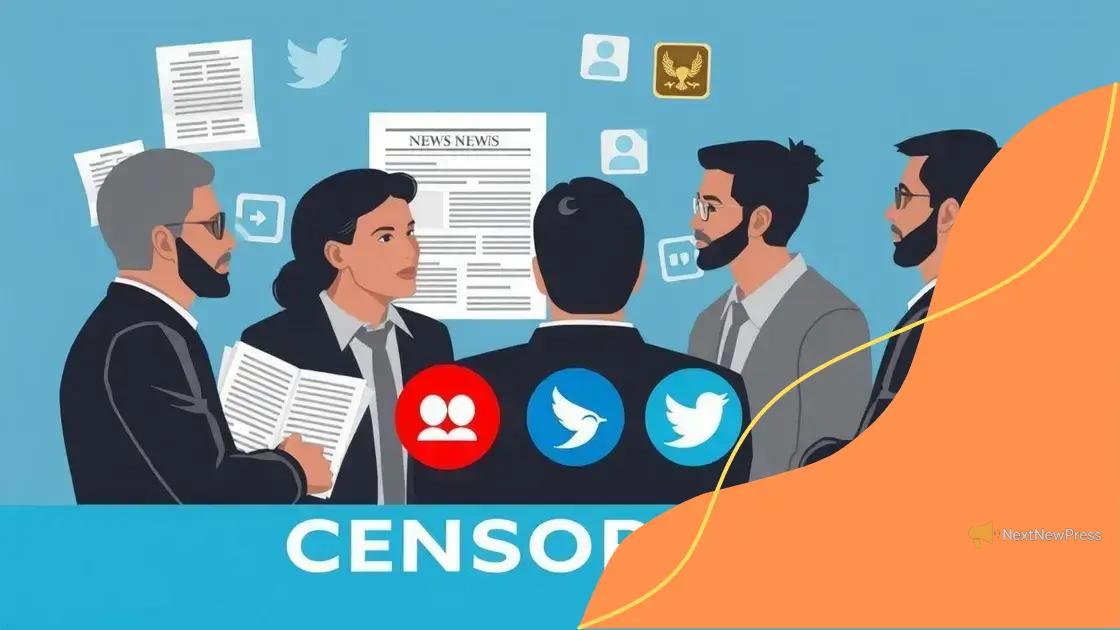Digital censorship and content moderation trends explained

Digital censorship and content moderation trends significantly impact free speech by restricting the expression of diverse viewpoints while evolving technologies like AI and blockchain shape future content management practices.
Digital censorship and content moderation trends are shaping the way we engage online. Have you noticed how some topics seem to vanish from discussions? Let’s explore how these practices affect what we see and share.
Understanding digital censorship
Understanding digital censorship is crucial in today’s online landscape. With more information shared online than ever, certain content often gets restricted or removed. This raises questions about freedom of speech and accountability in the digital age.
What is Digital Censorship?
At its core, digital censorship refers to the suppression of information online. This can be executed by governments, organizations, or platforms themselves. Content might be moderated for various reasons including:
- Protecting users from harmful material
- Adhering to legal obligations
- Maintaining community guidelines
However, the line between protecting users and infringing on free speech can be blurred. Many users feel that their voices are being stifled, which brings about a significant debate.
How Digital Censorship Works
Digital platforms use algorithms to determine what content is appropriate. These systems analyze user data and flag posts that might violate guidelines. For example, social media sites often monitor for:
- Hate speech and harassment
- Misleading information
- Violent content
While these practices aim to create safer online spaces, they can also lead to unintentional censorship of legitimate conversations. This situation creates a challenge for platforms to balance their responsibilities effectively.
In addition, algorithms can show bias. They may favor certain viewpoints over others, which can skew public discourse. It’s essential for users to understand how these mechanisms operate and their impact on the information they receive.
Ultimately, while digital censorship attempts to shape a safer online experience, it often generates significant debate on the ethics of such actions. Society must navigate these complexities, considering both the necessity of moderation and the principle of free expression.
The role of algorithms in content moderation
The role of algorithms in content moderation is vital in shaping our online experiences. These automated systems help platforms decide what content can be seen and shared. Understanding how they work is essential for everyone who uses social media.
How Algorithms Work
Algorithms use complex formulas to analyze data. They look for patterns that indicate whether a post is suitable. For example, they can detect offensive language or flag images that might not align with community standards. This technology allows platforms to manage large volumes of content efficiently.
- Filtering out inappropriate content
- Assigning visibility scores to posts
- Adjusting user feeds based on interests
However, these systems are not perfect. Sometimes they misinterpret context or fail to recognize sarcasm and humor. This can lead to unfair moderation, where legitimate content is removed or hidden. Users may feel frustrated when they see their feedback ignored.
Bias in Algorithms
Another important issue is bias in algorithms. They are designed based on historical data and can reflect existing prejudices. This might lead to certain voices being silenced more than others. For instance, sensitive topics can be unfairly targeted, resulting in unequal treatment of similar posts.
The trade-off between safety and censorship is complex. While moderation aims to protect users, it can also create a chilling effect where individuals hesitate to express their opinions. Understanding this dynamic is essential for advocating for better practices.
Moreover, as society evolves, algorithms must adapt. Developers need to constantly refine how these systems operate to ensure fairness and transparency. Continuous dialogue regarding their functionality will help create balanced online environments.
Case studies of recent censorship incidents

Examining case studies of recent censorship incidents offers valuable insights into how digital censorship operates in real life. These examples highlight the intricate balance between protecting users and preserving free expression.
High-Profile Cases
One notable case involved a popular social media platform removing posts related to a significant global event. Many users accused the platform of bias and questioned the motivations behind the censorship. This incident sparked widespread debate and raised concerns about how algorithms prioritize certain perspectives over others.
- Case of a viral video being deleted
- Social media ban on specific political figures
- Removal of content related to social justice movements
These events illustrate the power of algorithms in moderating public discourse. They also reveal the potential unintended consequences, where the removal of content can amplify the voices of those who feel unheard.
Impact on Public Awareness
Another incident involved a news organization that faced restrictions when reporting on governmental actions. Their posts were flagged for potential misinformation, yet many followers argued that it was essential information. Such cases point to the challenges news outlets encounter in an increasingly regulated online space.
Public awareness is crucial in these situations. Many users are unaware of how content moderation works, leading to confusion and frustration. As more restrictions emerge, users are encouraged to stay informed and advocate for transparency regarding what is allowed online.
Moreover, these case studies show a pattern where organizations often react to criticism, adjusting their policies in response to public backlash. This evolving relationship between users and platforms underscores the need for ongoing conversations about safety and freedom of speech.
Impact on free speech and expression
The impact of digital censorship on free speech and expression is profound and multifaceted. Many users find themselves grappling with the boundaries of what they can say online. These restrictions can shape public discourse and influence societal values.
Censorship and Freedom
When content is moderated, it raises questions about who controls online narratives. For instance, certain posts may be removed for violating guidelines, yet users often perceive this as an attack on their right to speak freely. This sense of limitation can discourage individuals from sharing their views, leading to a less diverse range of opinions.
- Feeling of oppression among users
- Reduction in meaningful discussions
- Fear of repercussions for expressing opinions
Moreover, instances of censorship can spark public outrage, prompting users to advocate for their rights. As a result, many online platforms are pressured to revise their content policies in response to growing demands for transparency.
The Balance of Safety and Expression
While the intention behind moderation is often to create a safer environment, the consequences can paradoxically undermine the very values it aims to protect. There’s an ongoing challenge in balancing user safety with freedom of expression. Many advocates argue that this balance is crucial for a healthy democratic society.
The digital space should encourage open dialogue, allowing individuals to express dissenting views without fear of retaliation. When free expression is curtailed, the robust exchange of ideas that fuels progress and innovation is stifled. Public figures and activists frequently highlight how censorship can modify the landscape of political engagement, thus affecting the overall health of democracy.
In light of these issues, it’s essential for users to engage critically with the platforms they use and understand how censorship affects their rights. Ongoing discussions around these topics are vital for shaping future policies that respect both safety and expression.
Future trends in digital content management
Future trends in digital content management are set to reshape how we interact with online platforms. As technology continues to evolve, so do the strategies for managing digital information and user interactions. Understanding these trends is essential for navigating the complex landscape of online content.
Emerging Technologies
One major trend is the use of artificial intelligence (AI) in content moderation. AI algorithms are becoming more sophisticated, enabling platforms to better identify and manage harmful content. This technology can learn from user behavior and adapt its strategies effectively. For instance, AI can help quickly flag inappropriate material, making moderation more efficient.
- Increased accuracy in content detection
- Reduction of human bias in moderation
- Faster response times to flagged content
As AI advances, we can expect it to play a critical role in shaping community guidelines. This will ensure that platforms enforce rules consistently while respecting user rights.
Decentralization of Content Platforms
Another trend is the decentralization of content platforms. As concerns about censorship grow, users are seeking alternatives to mainstream platforms. Decentralized systems allow for greater user control and fewer restrictions on speech. Users can share their ideas without the fear of being silenced by an algorithm.
This shift could lead to diverse online communities where content is managed collectively. Users will actively participate in decision-making processes, ensuring that moderation reflects the community’s values.
The influence of blockchain technology is also rising in digital content management. With its transparency and security, blockchain can provide solutions for copyright issues and secure content ownership. These innovations might revolutionize how users interact with digital assets.
In summary, the future of digital content management will likely be shaped by AI advancements, decentralization, and emerging technologies like blockchain. These trends promise to enhance user experiences by promoting safety while encouraging freedom of expression.
FAQ – Frequently Asked Questions about Digital Censorship and Content Management
What is digital censorship?
Digital censorship refers to the suppression or regulation of online content by governments, organizations, or platforms to manage the type of information available.
How do algorithms influence content moderation?
Algorithms analyze user data to determine which posts are appropriate, automatically flagging content that may violate community guidelines.
What are the potential impacts of censorship on free speech?
Censorship can limit free speech by making users hesitant to express their opinions, affecting public discourse and the diversity of viewpoints.
What trends are shaping the future of digital content management?
Emerging trends include the use of AI for better moderation, decentralization of platforms for greater user control, and the application of blockchain for transparency in content ownership.





